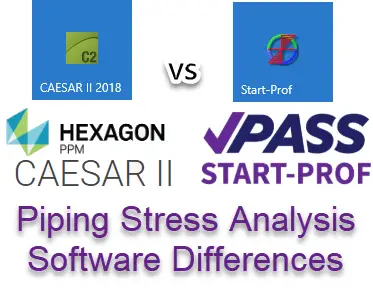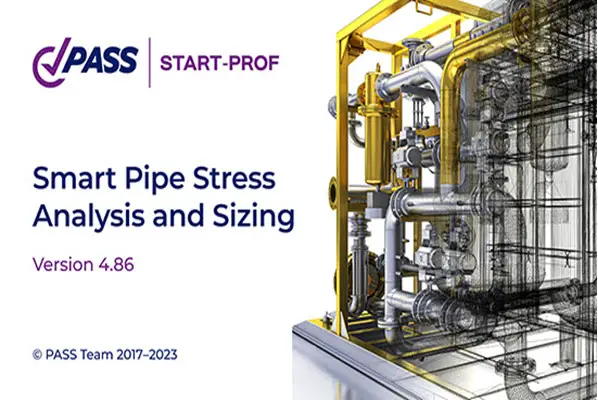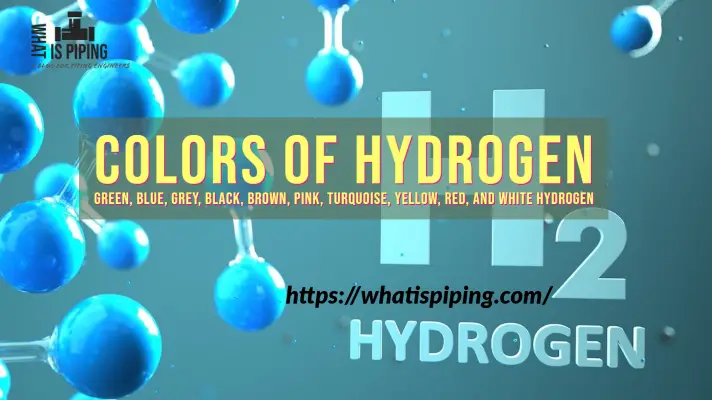Some of you must be aware that Hexagon has released their new version of stress analysis software, Caesar II Version 14 recently. The latest software version has truly extended its capabilities by incorporating many changes based on user feedback from the Caesar II user community. The much-awaited Hydrogen piping and pipeline code (ASME B31.12) is included in Version 14 of Caesar II software. In this article, we will highlight some of the new capabilities that you will find when you install Caesar II Version 14 on your PC/laptop. So, let’s start with the changes in codes and standards.

Newly Added Codes and Standards
As already mentioned, support for ASME B31.12-2019 has already been added to the new software. Additionally, most of the codes are updated to have their latest available editions. Let’s have a look at all the code changes below:
ASME B31.12 – 2019 Hydrogen Piping and Pipelines, including Part IP Industrial Piping and Part PL Pipelines. The allowable stress auxiliary data tab has been updated to support this new code addition. The configuration editor is updated to use alternative rules for stress range evaluation for supporting ASME B31.12 Appendix-B.
ASME B31.3: Process Piping– 2022 edition: This means they must have included the stress range reduction factor calculation based on the recent changes in ASME B31.3-2022. Click here to learn all the major changes in ASME B31.3-2022 as compared to its earlier edition.
- ASME B31.1: Power Piping – 2022 edition.
- ASME B31.4: Pipeline Transportation Systems for Liquids and Slurries- 2022 edition.
- ASME B31.8: Gas Transmission and Distribution Piping Systems- 2022 edition
- ASME B31.5: Refrigeration Piping and Heat Transfer Components- 2022 edition
API 617: Centrifugal Compressors- 2022 edition (9th edition) for equipment analysis. Now users can use an allowable load multiplier greater than 2.0 with manufacturer approval.
ASCE 7 – 2022 edition for wind and seismic loads. The Seismic Wizard in piping input has been updated to support ASCE 7-22 and IBC 2021. Additionally, the Wind Loads Tab (Static Analysis – Load Case Editor Dialog) and the DLF/Spectrum Generator are also updated to support ASCE 7-22 and IBC 2021.
- EN-13480-3:2017/A5:2022 (Metallic industrial piping – Part 3: Design and calculation).
- IBC – 2021 edition for wind and seismic loads.
Updates in Material and Content Database
As the major code changes in Caesar II Version 14 are already stated, let’s learn the other changes that the software release in 2024 will provide:
- Caesar II Version 14 is further enriched with the following additions:
- Added 119 material records for B31.12-2019 into the material database. The physical property data is taken from ASME B31.3-2018 and ASME BPVC Section II Part D-2021. While the allowable stress data is taken from ASME B31.12-2019
- Added fifth working range quadruple springs to the ANVIL hanger tables. Also added spring sizes 000 and 00 for the B-268 springs.
- Added the fourth and fifth size springs to the PSSI Group hanger tables.
- Added hanger tables for Rilco Manufacturing pipe supports.
Improvements in Static and Dynamic Analysis
The software version 14 has enhanced its capabilities to consider the thermal bowing load when defining a Thermal Bowing Delta Temperature and define an operating temperature that is the same as or close to the Ambient Temperature. A new technical discussion for thermal bowing is also added to help explain the condition thoroughly.
The program has updated the Dynamic Analysis calculations for the B31.4, B31.8, B31.4 Chapter IX & Chapter XI, and B31.8 Chapter VIII piping codes with multiple offshore and transportation code stresses. The changes have a significant impact on the time history and spectrum analysis.
Caesar II Version 14 now supports the MDMT calculations devised in the ASME B31.3-2022 edition.
Other Improvements
Other significant changes to Caesar II Version 14 as compared to Caesar II Version 13 are:
- The SIF Multiplier for Sustained Stress Index option in the Configuration Editor is added for Piping codes that use ASME B31J.
- The equipment analysis using NEMA SM23 for Steam turbines has been updated to allow the Allowable Load Multiplier to be greater than 2.0 with manufacturer approval.
- The output report for for primary stress types (example: SUS, OCC, and HYD) now displays sustained intensification factors (SSI) for metallic piping codes.
- The option for creating a combined PDF output report has been activated in the Output Viewer Wizard of the Static Output Processor.
- The length for displaying your company name on output reports has been increased by 30 more characters.
- A new offline version of help has been added for installations that do not have internet access to the online help. Offline help now opens in your default web browser.
So, from the above discussion, you can easily understand that Version 14 of Caesar II software comes with many advancements to help users perform their analysis with more accuracy following all the latest developments in codes and standards. It also fixed most of the issues that users have faced in Caesar II version 13. Some of the notable fixes made in Caesar II version 14 are:
- The implementation of ISO 14692-2005 when a stress type has no envelope has been changed. The stress reports in the latest Caesar II software program will now display the maximum between hoop stress and longitudinal stress instead of always displaying the hoop stress.
- Fixed the issue of requiring all flange yield strength field inputs (SY1 through SY9 when temperatures T1 through T9 were not defined) in the NC-3558.3 flange leakage checking.
- The incorrect EN 10269:1999 material number for X2CrNiMo17-12-2 has been fixed.
- The incorrect gasket diameters for the ASME-2009 and ASME-2009M – Class 900 databases have been updated with correct values.
- Fixed the error of the Type list for B31J SIFs & Tees sometimes that did not display correctly.
- Fixed the issue of B31J surface nodes not renumbering when renumbering all nodes.
- Fixed Caesar ii import issues from Smart 3D/ SmartPlant Review .vue files, CADWorx .dwg file.
References and Further Studies:
https://docs.hexagonali.com/r/en-US/CAESAR-II-Quick-Reference/Version-14/328888









Bug in Global Coordinates of disconnected pipe segments also fixed.